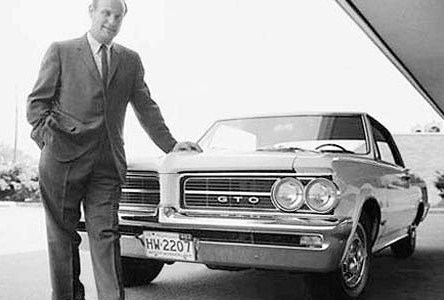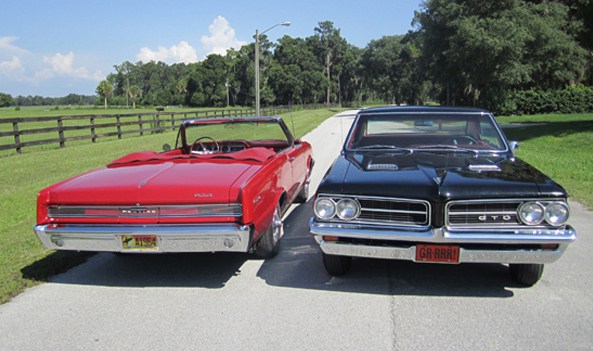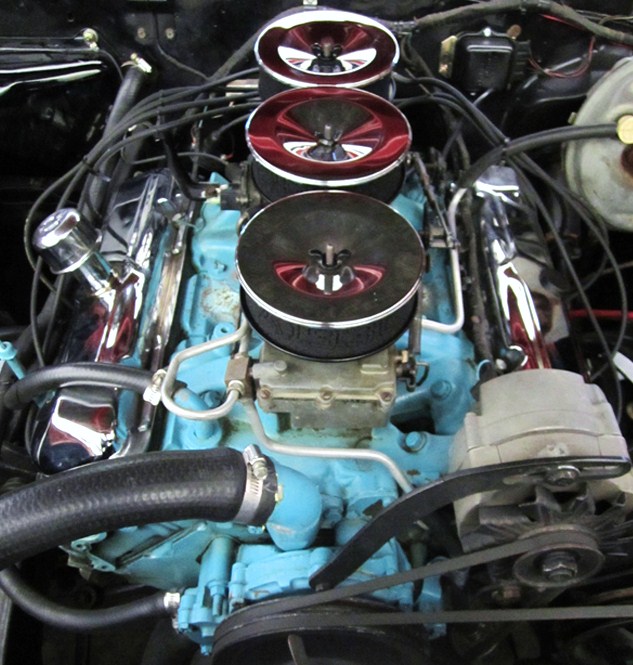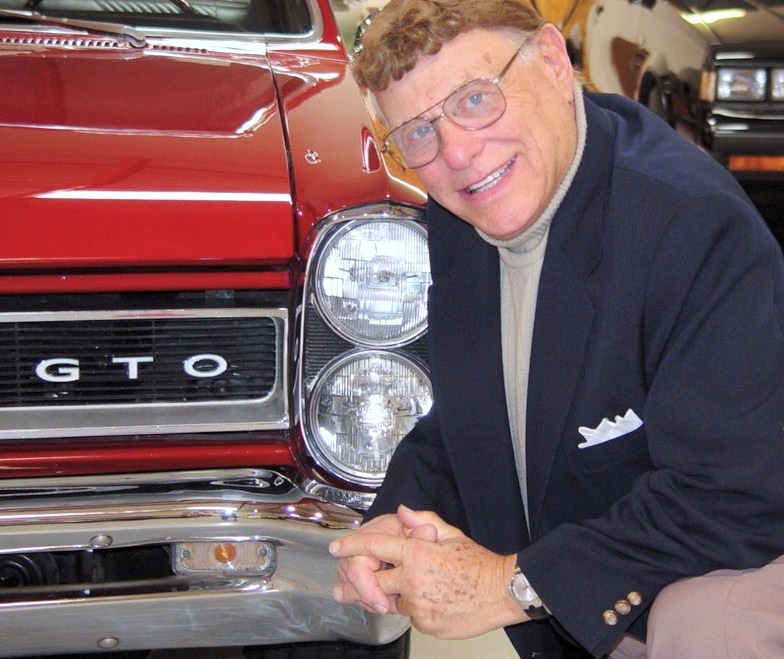
As any Pontiac enthusiast would tell you, the 1964 Pontiac GTO was never supposed to happen. The legend of how the groundbreaking muscle car came to exist against all odds will be told time and again this year as the performance icon celebrates its 50th anniversary.
Although there were muscle cars that came before, the 1964 Pontiac Tempest Lemans GTO is credited with starting the trend of sporty, youth-oriented performance cars from Detroit that ruled during the tumultuous 1960s. GTO is what sparked the muscle car wars among the major U.S. brands.
But to bring the original 1964 GTO to market, Pontiac had to sneak it under the conservative noses of General Motors management and deliver the cars to dealers without official approval. The whole story is told in Glory Days, the autobiography by Pontiac’s acclaimed marketing guru, Jim Wangers.

Wangers is now known as the Godfather of the GTO, not because he invented the car but because of his aggressive marketing campaign that made everybody sit up and take notice. One of the important personalities who helped Pontiac come back from its near demise during the 1950s, Wangers was instrumental in building Pontiac’s image as General Motors’ style and performance division.
Pontiac finally was axed from GM’s lineup in October 2010 after a decline that Wangers blames on poor management that lost sight of Pontiac’s “excitement” mission.
Wangers credits the creation of the GTO to a trio of inspired Pontiac engineers: Bill Collins, Russ Gee and the remarkable John DeLorean, who would soon head the GM division. Their template was the redesigned Tempest, Pontiac’s smallest car.
“The idea of stuffing a big engine into a smaller or lighter-weight car was hardly original,” said Wangers in a telephone interview with ClassicCars.com. “The aftermarket had been doing it for years. But we were the first manufacturer to do it on a production basis.”
The key ingredient was replacing the Tempest Lemans’ standard 326-cubic-inch V8 with a 389 that produced 325 horsepower and 428 pound-feet of torque in 1964, or 348 horsepower with the Tri-Power option. The GTO came with trendy Redline performance tires, hood “scoops” and a bold GTO badge on the left side of its grille. A number of styling and performance options were also available.

Timing was everything with the original GTO, Wangers said, with a burgeoning population of young people who were looking to break away from the old ways of doing things, including driving.
“They were on a quest for personal mobility and for personal mobility with a little fun and a little enthusiasm,” Wangers said. “Then along came a set of wheels that was pretty exciting. A set of wheels that was not just exciting but reasonably priced. That’s really what combined to offer us the opportunity to move so aggressively in that direction.”
But that direction was not so obvious to the corporate heads of GM, who had earlier imposed strict rules and regulations that limited engine size and horsepower to all but the automaker’s biggest land yachts. The idea of producing an intermediate-size performance model with a large, powerful engine was heretical.
GM was also under pressure from the government because the company commanded so much of the automotive market in the 1950s, about 55 percent in the days before significant numbers of imports arrived on the scene.
“So GM management was always concerned with their bigness and their aggressiveness. The last thing they wanted to do was to go out and promote performance,” Wangers said. “Promoting fun driving to young people could have been considered to be socially irresponsible; here’s GM trying to kill our kids with these high-performance cars.”

In the spirit of the rebellious 1960s, the Pontiac people took secret advantage of a loophole in GM’s rulebook that would allow them to offer the car not as a separate model but as an options package for the Tempest Lemans. That way, they could stay under the radar as they introduced this new kind of performance car to the public without waiting for approval from the higher ups.
“So the cars were in the hands of the dealers, 5,000 of them, before the corporation ever knew that it existed,” Wangers said. “For one of the divisions to sneak, so to speak, a special car into the market, it couldn’t be done today. In this case, we had control over some of our assembly activities.
“We didn’t initially inform the corporation, and they first heard about it from the Chevrolet and Oldsmobile divisions, because when the Pontiac dealers got their hands on these cars, the first thing they did was take it over to their buddies at the Olds or Chevy or Buick dealership and said, ‘Hey, look what I got.’”
When the GM honchos found out about the ruse, they summoned the Pontiac guys to headquarters to explain themselves.
“They gave us 30 days to put together our presentation,” Wangers recalled. “Well, during that 30-day period after the car went into the field, the dealers had quite an experience when Pontiac got more than 15,000 orders for the new car. The dealers got one or two depending on the size of the dealership, and when they realized what they had, they turned around and said, ‘Hey, get us 10 more of these.’

“When we showed that to the corporation, our meeting was over. They said, ‘Well this is ridiculous, we’re sure not going to kill that.’ Then they turned to Chevrolet, Buick and Olds and said, ‘OK, you can have one, too.’”
Pontiac would sell more than 32,000 GTOs during the 1964 model year.
GTO would stand alone for a year before the other GM divisions introduced their competing versions of midsize muscle cars. Pontiac had been able to quickly design and introduce the GTO, Wangers said, because the stock 326cid V8 in the Tempest Lemans had the same block as the 389cid, including the motor mounts, making it simple to install the bigger-displacement engine.
But for the other divisions, their bigger performance engines were entirely different from the standard engines, requiring re-engineering of such things as the motor-mount locations.
“Stuffing that bigger Pontiac engine into that intermediate size car was not a problem. But when Chevrolet, Olds and Buick went to work and tried to duplicate that, they realized that they had different engines with completely different sets of motor mounts,” Wangers said. “So even though they had muscle car answers to the GTO in the model year 1964, it wasn’t until well into 1965 before they appeared with the bigger engine in an intermediate car.”
Ford and Chrysler also would respond in the ensuing years, and the horsepower wars were on.

At 88, Wangers is having a busy year traveling around the country for appearances at GTO club events and other anniversary celebrations. He already has been hosted by the Petersen Automotive Museum in Los Angeles and the Blackhawk Collection in Danville, Calif., for exclusive speaking engagements.
“I was fortunate enough to be there and live through it,” he said. “There are not too many of us left.”
Tom Szymczyk, the editor of The Legend Magazine – the official publication of the GTO Association of America – said he’s looking forward to Wangers’ appearance at the GTOAA Convention from July 1-5 at the Monroeville Convention Center in Monroeville, Pa.
“We’re making a big birthday party out of it,” Szymczyk said of the national convention.
By the way, it was John DeLorean who came up with the name GTO, taking the letters from the iconic Ferrari 250 GTO race car, which stirred protests from Ferrari enthusiasts and sports-racing fans. For the Ferrari, GTO stands for Gran Turismo Omologato, Italian for Grand Tourer Homologated for that racing class.
The Pontiac GTO wasn’t a race car, per se, though it was raced a lot from stop lights. But the name was an inspired move. GTO quickly became synonymous with Pontiac performance for American drivers, and it still rings true today.





My first new car, what memories. So much fun to drive. A great combination of size and performance.
VL, Tempe, AZ
My 1st Pontiac 1967 GTO, than a 1970 than a 1972 GTO, from 1971 to 1986 I drove them to work, to church, to Hospital having 4 children they never let me down. Style, C lassie, Sexy, Power.
2nd car was a 1968 GTO…you know, rubber bumper, flippin headlights, Verdura? Green. Car always came “alive”, after dark, on windy roads, traveling the 180+/- miles from Indy to Evansville. 1st nite out, the rubber gas line ‘kinked’ and had to have it towed. Rolled it, with 648 miles. 3 times side to side, once end over end. All panels trashed, except trunk lid and back window, therefore, back then, it had to be repaired. Dealer bodyshop did repair and was better a finish than when delivered.
Loved that car
my friend ‘al the mag wheel’ had a 64 gold convertable with a 65 front nose. we would go cruising on L.I. N.Y. roads and drink shlitz 8 oz. malt liquer before they had breath anilizers. we never drank much but had a lot of fun trying to pick up girls by honking the horn and peeling out at lights with the 389 4 barrel automatic tranny. That car was unique as he bought it from some guy in 1970 when he got back from vietnam. I always felt it was a one of a kind custom job that some body shop put together when the previous owner cracked it up. Does anybody remember that car as i lost contact with my New Hyde Park friend and he has long sold it.